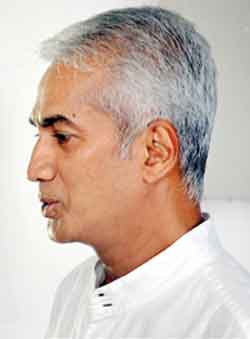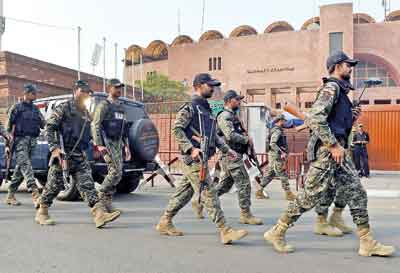It was a long overdue obligation – Sidath Wettimuny
View(s): Right now, there are more unanswered questions than the ones that have already found solutions, stuck in the inbox of Maitland Place cricket office. At one juncture, it was presumed that Sri Lanka’s cricket was back on its feet when the Lankans only shed a drop of sweat or two at the most, to beat Pakistan twice, to take the Test rubber. At that time the elated players, especially the senior ones exuded loads of bonhomie on the team management and went into raptures to explain as to how the worm turned.
Right now, there are more unanswered questions than the ones that have already found solutions, stuck in the inbox of Maitland Place cricket office. At one juncture, it was presumed that Sri Lanka’s cricket was back on its feet when the Lankans only shed a drop of sweat or two at the most, to beat Pakistan twice, to take the Test rubber. At that time the elated players, especially the senior ones exuded loads of bonhomie on the team management and went into raptures to explain as to how the worm turned.Then they switched their white gear and for the coloured outfit, to complete their ODI assignment. But, what transpired was a carbon copy of the infamous Aussie debacle. The Lankans won the Test rubber against the Aussies and got decapitated in the ODIs. The only difference was that the former occurred in our own backyard.
From the very outset, the Lankans were slipping. Suddenly, the combination of Lankan cricketers who won a Test series was cut down to size. From the playmakers in the Test squad, only Dimuth Karunaratne, who was the highest scorer in the Test series with 306 runs, along with left arm magician Rangana Herath returned home. Now a section of the public is moaning the absence of Dhanushka Gunatilleke, Angelo Mathews, Kusal Janith Perera and Asela Gunaratne. Ironically, at one instance or more, this foursome who are now injured, were also members of the teams that suffered series defeats against Australia, South Africa, Zimbabwe and India.
As for me, the most disturbing factor is the players losing their resolve. This is where it hurts. At one juncture, opener Niroshan Dickwella looked unstoppable, but now, he is finding it difficult to put bat to ball. Skipper Upul Tharanga’s batting prowess wilted like a plant running out of water.
Dinesh Chandimal, in his early days, scored an ODI 100 at Lords and was the next thing coming in Lankan cricket. I still remember his knock in Australia, in that crucial game against the Australians, when only a torn ligament stopped him and the Lankans. But now, he is more occupied in the pavilion than in the playing arena, as far as Sri Lanka’s batting is concerned.
Even in bowling, the lads are groping in the dark! Is it Seekuge Prasanna or Jeffrey Vandersay? What is the roll of Akila Dhananjaya or Malinda Pushpakumara?
Fast bowler Dushmantha Chameera has bagged only one wicket in his last nine matches with an average of over 250 runs….. Certainly, it is not international class bowling. He is a new generation fast bowler who can hit the paddle at 140+kms. He started in January 2015 and his first seven games were okay, but not remarkable. But, his post-injury run has been forgettable. Now the question is why? Has he fully recovered from his injury? Unquestionably, we cannot carry passengers into the next ICC World Cup work-plans. At least, he should be the bowler he was at the beginning of his short career for him to be productive in the international potpourri.

Pakistani Rangers march outside the Gaddafi Cricket Stadium in Lahore on Friday. Tens of thousands of security will be deployed in Lahore on Sunday when Sri Lanka become the first major cricket team to visit Pakistan since they were targeted in a deadly ambush in 2009 -- with attack survivors among those returning to the scene - AFPw
There is something amiss we say! The players who are not performing at present are better than what the scorebook says. They do have the potential and talent but, we are trying to ascertain as to where we have gone wrong? At one juncture, we thought the fault lay with the Sanath Jayasuriya doctrine. But, we find the same shifting bouts in the Lankan team still persist. So, definitely there is some rotten fish in the cooking pan, and now the curry smells.
We even think that the Lahore hullabaloo could have had a lesser impact on the players.
There was resistance in this attempt right from the beginning. Well, fast bowler Suranga Lakmal, who was wounded while making his maiden overseas tour to Pakistan, may still have a lot of dressing room quips to share with his cricketing brethren. So, obviously, there has to be antipathy.
But, there are some things that are bigger than sport and sometimes, they are unwritten obligations. When Australia and the West Indies refused to face Sri Lanka in Sri Lanka, in the 1996 World Cup tournament, there was a huge uproar. At that juncture, two unlikely foes united and made up a team comprising Indian and Pakistani players for a match played in Colombo, in spite the war situation in the country. In reality, this opened the pathway for many a thing. By playing that game in Sri Lanka, the Lankans broke the ice and the rest is history.
In that element, we owe Pakistan a huge debt. But what transpired in 2009 — when the Pakistan bus carrying Sri Lankan cricketers was ambushed, after the home team had coaxed the Lankans to make a tour of the country during their internal strife — put a stop to international cricket in that country at all levels.
The country which broke that ice was Zimbabwe with an ODI and T-20 tour to Pakistan in 2015. The then Lankan cricket boss Sidath Wettimuny who was a guest of the PCB, explained to the Sunday Times about his experience.
“We always thought that Pakistan stood by Sri Lanka on many a count. When I was the Interim head, the Pakistani authorities requested we should make at least a short tour of Pakistan but, at that time, we did not have any commitments there. But, when I was invited to visit Pakistan, to witness the matches against Zimbabwe, I gladly accepted the offer.
 “When we arrived for the match in Lahore, there was a security blanket. Even the hotel we stayed in was well fortified and there was a sense of security. Then, when it came to the match proper, the security was phenomenal. The entire area of the match location was cordoned off and every single spectator was bodysearched about a kilometre away from the ground, and the same thing happened at the gate. Even for a moment, we did not feel insecure.”
“When we arrived for the match in Lahore, there was a security blanket. Even the hotel we stayed in was well fortified and there was a sense of security. Then, when it came to the match proper, the security was phenomenal. The entire area of the match location was cordoned off and every single spectator was bodysearched about a kilometre away from the ground, and the same thing happened at the gate. Even for a moment, we did not feel insecure.”
Then Wettimuny said “In spite of all that security, the matches were a sellout, even though Zimbabwe was the opposition. The atmosphere was electric. I just gathered how the Pakistani public had been starved of entertainment. The people who watched the proceedings were more than pleased.”
Yet, leaving aside past obligations, how can you possibly say an in-and-out operation of this nature be taken as proof of security in Pakistan. Doesn’t this amply prove there still is a looming threat and they cannot take things for granted. Given the conditions, there may not be any attempts by undesirable elements to create mischief. But still, is Pakistan a safe place to play day-to-day international cricket?


